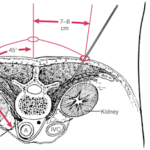The sympathetic nerves run beside the spine. The lumbar sympathetic nerves in the lower back control the blood vessels in the legs, and carry some of the sensation of pain from the legs.
Pain in the legs, particularly when it is related to problems in the blood supply to the legs, can be helped by numbing the sympathetic nerves.
The injection
We usually start with a test, injecting a local anaesthetic (bupivacaine) and sometimes a steroid (methylprednisolone) to reduce inflammation around the nerves. This test will show that the pain can be treated by turning off the sympathetic nerves. The help is temporary, but any problems are also temporary.
When the injection is performed, you will need to lie on your stomach for about 20 minutes. A small needle is put into a vein on your hand or forearm so that we can give medicines rapidly should they be needed. An X-ray machine is used to take pictures of the injection. If there is any possibility of pregnancy, then we cannot perform the injection. The site of the injection is cleaned with cold antiseptic. A small injection of local anaesthetic (lidocaine), which stings for a few seconds, is used to numb the skin on either side of the middle of the back.
One or more needles are then pushed through the skin, on the side of the back, and carefully moved past the backbone to lie next to the sympathetic nerves. This may take a few minutes, and is sometimes uncomfortable. The needles are checked by injecting a small amount of iodine-containing dye (iopamidol) that shows up in the X-rays.
The treatment is then injected. You may feel some warmth, a little discomfort, or some numbness.
Because of the effects of the injection, you should not travel home alone, and someone should stay with you on the day of the injection.
If the pain is helped but returns then you wili be asked to return for a long-lasting treatment. This is done in the same way, but the injection includes a chemical (alcohol or phenol) that wili kill the sympathetic nerves. The injection will last for several months until the nerves grow back.
Problems
The most common problem is a drop in blood pressure, and a feeling of faintness after the injection.
The most serious problem is damage to nearby organs from spread of the injection beyond the sympathetic nerves. The nerves to the groin can be affected in up to 10% of patients, and sometimes become painful themselves for a few weeks. The problems occurring after long-term treatment include paralysis of the legs, unpleasant sensations in the legs, impotence and bladder incontinence, but occur rarely.
The injection cannot be given to patients who are sensitive or allergic to the drugs and chemicals used. We put a dressing over the injection, and you should tell us if you are allergic to plasters, tapes or dressings. It is too dangerous to perform the injection on patients with clotting problems, or are taking anticoagulants. It is also too dangerous to perform the injection when there is an infection of the abdomen or the skin of the back, or septicaemia.



